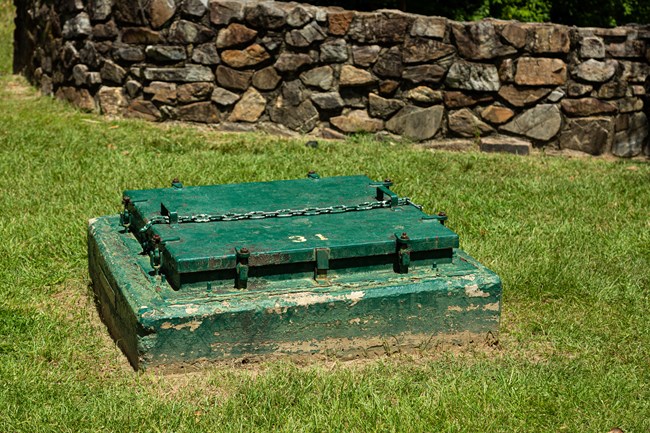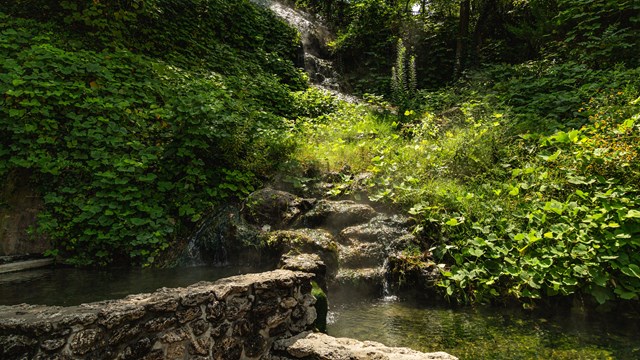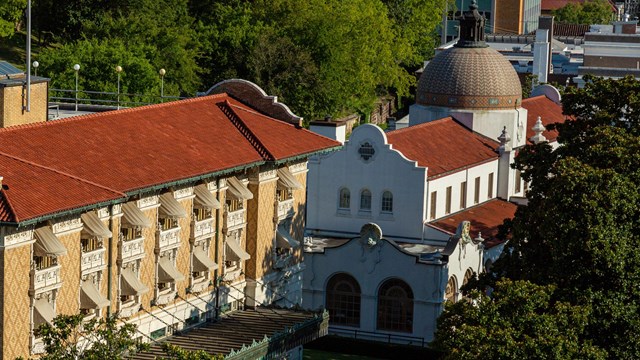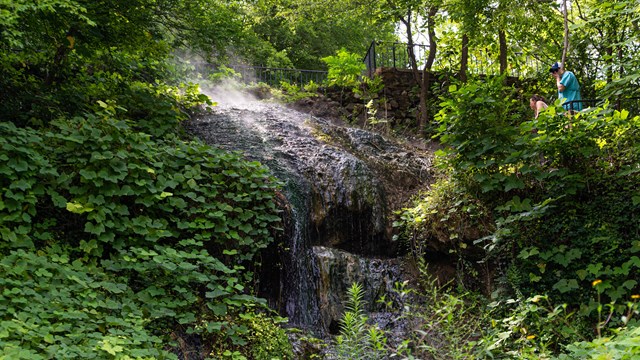
NPS Photo/Mitch Smith Where are the Hot Springs?The hot springs are located on about 2.8 acres along Bathhouse Row and the Grand Promenade, at the base of Hot Springs Mountain. The bulk of the approximately 700,000 gallons of thermal water flowing each day from Hot Springs Mountain is collected from 27 of the 47 presently active springs. What are those Green Boxes?Each spring in the collection system has been sealed and covered with a green box about four feet square with a metal cover, chain, and padlock. The green boxes on the lower west slope of Hot Springs Mountain and the heat exchange units at the north end of Bathhouse Row are the most visible components of the thermal water collection and distribution systems and represent its source portion. Not all of the boxes indicate a spring; some hold only valves and collection plumbing. The boxes higher up on the mountain allow access to underground reservoirs and plumbing. What is the Plumbing System Like?The valve and spring collection boxes are connected with the plumbing system delivering thermal water to reservoir under the east end and parking lot of the administration building at the south end of Bathhouse Row. This reservoir holds about 268,000 gallons and includes an overflow pipe connected to the Hot Springs Creek arch. There is a weir where the water flows into the reservoir and one where the overflow water drains into Hot Springs Creek to measure how much water is collected each day and how much is overflow. This data is collected by the United States Geological Survey and is available on their website. In the administration building basement, two pumps (P-1 and P-2) move the thermal water through a twelve-inch cast-iron pipe in the Hot Springs Creek arch to the bathhouses, the heat exchangers, and a 100,000-gallon underground storage reservoir (R-3) about 120 feet above Bathhouse Row. The elevation of this reservoir ensures an ample supply of water at about 52 pounds per square inch (psi) when pumps P-1 and P-2 are idle. When demand increases, pumps P-6 and P-7 transfer thermal water from reservoir R-3 to another 100,000-gallon reservoir (R-4) about 220 feet above Bathhouse Row. The plumbing for a number of bathhouses no longer in operation is still in the distribution system as well. Do you change the water temperature?Surprisingly enough the water within the distribution system stays well above 100º F (37.8º C); the water has been flowing into it for decades, and the terrain around the reservoirs and plumbing is heat saturated. As a result, the water arriving at the bathhouses is far too hot for direct bathing. By mixing hot and cooled spring water, bathhouse attendants can administer baths at the temperature (98º to 100º F, 36.7º to 37.8º C) required by regulations. The system was designed to produce thermal water cooled to temperatures ranging from 75º to 90º F (24º to 32.2º C). During most of the year when outdoor temperatures are below 80º F (26.7º C), the system works well, but during the hot summer months the desired temperature range is difficult to achieve. To compensate, heat exchanger #2 has been redesigned, and installation of new equipment began in the first quarter of 2001. 
NPS Photo/Mitch Smith 
Experience the Water
Learn about the various ways that you can experience the thermal springs in the Park. 
Things To Do
Explore, Learn, and Relax! Learn all about the things to do in our Park. 
Hot Springs Geology
The story of the Park's thermal springs begins with rocks that formed over 400 million years ago... |
Last updated: October 2, 2020
